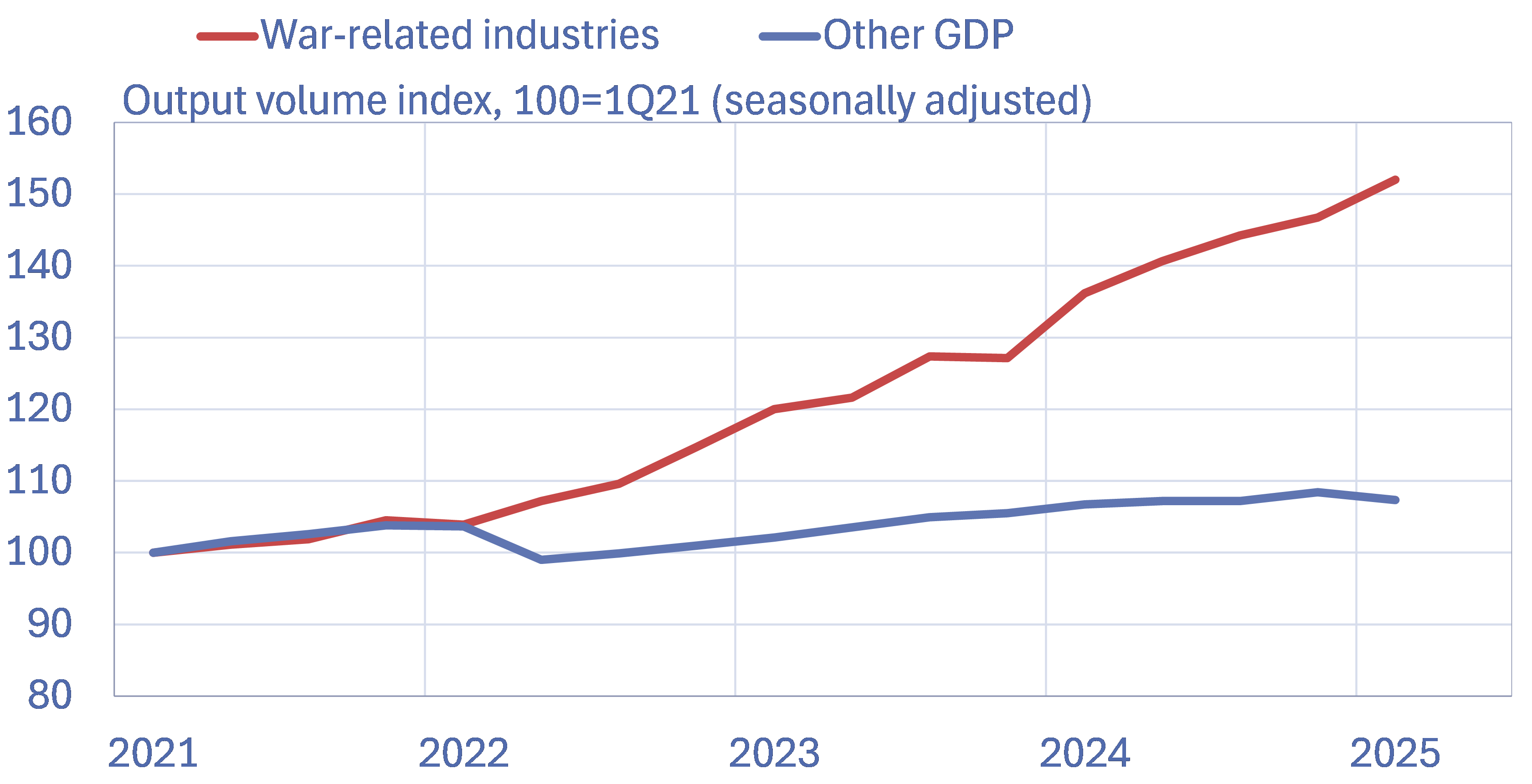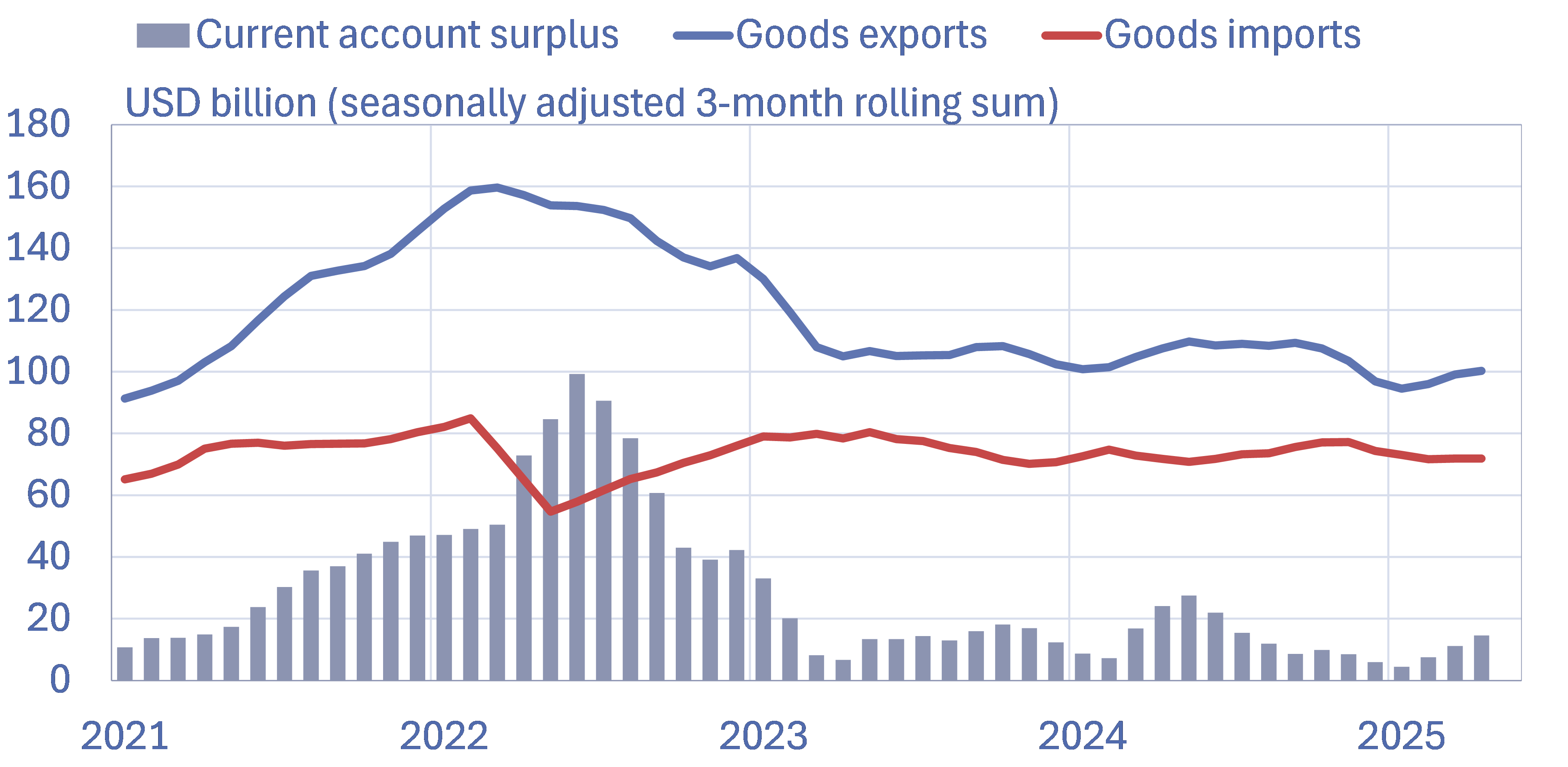BOFIT Weekly Review 27/2025
Concerns emerge over Russia’s slowing growth
Rosstat this week affirmed its preliminary first-quarter GDP growth estimate of 1.4 % y-o-y, bolstering the view that a substantial slowing of Russia’s economic growth is underway. 1Q25 GDP shrank from the previous quarter by 0.6 % – the first on-quarter decline in GDP since spring 2022 following the invasion of Ukraine. Annual GDP growth was still supported by war-related manufacturing industries and services. In contrast, mining and quarrying production, for example, contracted clearly in January-March, and the volume of wholesale and retail sales also decreased slightly.
A similar trend seems to have continued in recent months. The indicator depicting the production of five core sectors of the economy, which predicts GDP development, grew by 1.4% y-o-y in January-May. Mining and quarrying output contracted again in May year-on-year, while manufacturing production continued to grow. Retail sales grew moderately in May, as in previous months, but construction stagnated at the same level as a year earlier. Consumer prices rose by another 10% y-o-y in May.
Russia’s GDP forecasts have generally been lowered in recent months due to the worsening economic imbalances and the fall in oil prices. The World Bank’s forecast published in June expects GDP growth of 1.4% this year and 1.2% next year. Consensus Economics’ June report predicts GDP growth of 1.4% this year and 1.3% next year.
Russia’s GDP development weakened substantially in 1Q25, but production in war-related industries continued to increase

Note. The development of war-related industries is an estimate that covers three manufacturing industries most closely related to the war industry, as well as services related to public administration and national defense.
Sources: Rosstat, BOFIT.
Russia's federal budget deficit widens
According to preliminary data from the Russian Ministry of Finance, federal budget revenues grew by 3% y-o-y in January-May. Oil and gas revenues fell by 14%, driven by lower oil prices. Other revenues grew by 12%. However, In May total revenues contracted, as oil revenues fell sharply and other revenue growth slowed.
Federal budget expenditures grew by 20% y-o-y in January-May. In May, expenditure growth accelerated again after more moderate months, and expenditures were increased by as much as a third compared to a year earlier. As a result of the rapid growth in expenditures, the federal budget deficit widened to 3.4 trillion rubles (1.5% of GDP) in January-May.
At the end of June, President Putin approved a revised budget framework for this year. The new budget sees revenues lower than previously expected by about 1.8 trillion rubles, due to downward revisions to oil revenues. The oil price assumption was lowered from 70 dollars per barrel to 56 dollars per barrel. In addition, the assumption of ruble exchange rate was appreciated (94.3 rubles per dollar instead of the previous 96.5 rubles), which will reduce oil revenues calculated in rubles. Expenditures were increased by 800 million rubles despite lower-than-expected revenues. As a result, the federal budget deficit planned for this year is now significantly larger than previously expected, at about 3.8 trillion rubles (1.7% of GDP).
The liquid (readily available) assets of Russia’s National Welfare Fund have dwindled considerably. At the end of May, the value of the fund’s liquid assets was only about 2.8 trillion rubles, which is less than the deficit planned for this year. However, Russia will probably be able to finance the deficit without major problems by increasing its government debt. If necessary, additional revenue can also be obtained through tax increases.
Russia's current account surplus has narrowed this year
According to preliminary data from the Central Bank of Russia, the value of Russia's exports of goods and services in January-April decreased by 4% y-o-y. Exports were particularly weighed down by the fall in oil prices. According to estimates by the International Energy Agency (IEA), the average export price of Russian crude oil in January-April was 61 USD/bbl, or 10 USD lower than a year earlier. The value of exports of many other raw materials also decreased.
The value of imports of goods and services in January-April increased by 2% year-on-year. Imports of goods remained at the previous year's level, but imports of services increased by 6%. Of the largest product groups, imports of food and chemical products increased, while imports of machinery, equipment and transport equipment decreased slightly. According to Rosstat, tourist trips by Russians increased by 5% year-on-year in the first half of the year. The most popular travel destinations were the United Arab Emirates, Turkey and Thailand. The fastest growth was seen in tourism to Vietnam, where more than double the number of tourist trips were made compared to the previous year. Tourism to Turkey, on the other hand, decreased.
Russia's current account balance has remained in surplus, but the surplus has shrunk this year. In January-April, the surplus amounted to 22 billion dollars, compared to 31 billion dollars a year earlier.
The value of Russia's exports of goods has decreased this year, while the value of imports of goods has remained unchanged

Sources: Macrobond, Central Bank of Russia, BOFIT.
Russia's economic situation was discussed at St. Petersburg Economic Forum
A leading topic at this year’s St. Peterburg Economic Forum (June 18–21) was whether the slowing Russian economy is headed for a controlled “soft” landing or falling into recession. The debate split along familiar lines. The economic development ministry and companies argued for lower interest rates and government subsidies to stimulate the economy, while the finance ministry and central bank called for stricter fiscal discipline and keeping high interest rates in place. Economic development minister Maxim Reshetnikov lamented that the high key rate was driving the economy into recession. Directors of Russia’s large banks and corporations complained that high interest rates are holding back investment and causing payment problems. In response, Russian finance minister Anton Siluanov and central bank governor Elvira Nabiullina claimed that a slowdown in output growth was inevitable as the artificially high growth of recent years was unsustainable.
In his headline address to the forum, president Putin set out Russia’s needed economic reforms, noted that the economy needs to create high-paying jobs, improve the investment climate and increase the pace of at which the economy adopts advanced technology. The focus on exports also needs to shift from raw commodities to high-tech goods & services, while the emphasis of imports should shift from high-tech products to labour-intensive goods. These goals have been on the agenda in Russia's various development strategies for years, but little progress has been made. Now Putin also highlighted the development of the defense industry as a key part of economic reforms. The defense and civilian industries must be more closely integrated, and companies should no longer be separated into defense and civilian sectors.